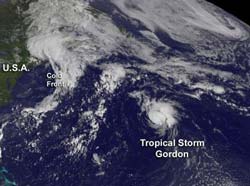The wasp that never cries wolf

European paper wasps (Polistes dominula) advertise the size of their poison glands to potential predators.<br><br>Credit: Francisco J. Zamora-Camacho<br>
Aposematism is used by many different animals to warn potential predators that they are poisonous. Usually this takes the form of distinctive colouration or patterns which predators quickly learn to avoid.
Paper wasps have conspicuous yellow and black patterns covering their bodies and researchers from University of Granada and the University of Almería found that when they compared the size of a wasp's poison gland to the brightness of its colour there was a direct relationship.
Dr Gregorio Moreno-Rueda, who led this study explained, “It might be thought that bigger wasps have bigger poison glands, and this is indeed true, but even when the data was adjusted to take in to account the size of the insect, a positive correlation between gland size and brightness remained.”
But producing both the poison and the distinctive colouration is costly to the wasp. To get around this problem some species, such as hoverflies, have learnt to mimic poisonous ones. But other animals use colouration as a truthful (Zahavian) signal. In this case the wasp would be signalling that it is so strong and healthy that it can waste energy producing bright colour; and a strong and healthy wasp will contain a lot of poison.
Dr Moreno-Rueda continued, “A second possibility is that the pigment is also an antioxidant that helps protect the insect from its own poison or from the by-products of poison production. Consequently an insect which has a lot of poison will also have a lot of colour.”
Either way predators need to beware – a bright wasp will leave a nasty taste in the mouth.
Notes to editors
1. Risk Brighter-colored paper wasps (Polistes dominula) have larger poison glands
J Manuel Vidal-Cordero, Gregorio Moreno-Rueda, Antonio López-Orta, Carlos Marfil-Daza, José L Ros-Santaella and F Javier Ortiz-Sánchez
Frontiers in Zoology (in press)
Please name the journal in any story you write. If you are writing for the web, please link to the article. All articles are available free of charge, according to BioMed Central's open access policy.
Article citation and URL available on request on the day of publication.
2. Frontiers in Zoology is an open access, peer-reviewed online journal publishing high quality research articles and reviews on all aspects of animal life.
3. Please credit attached image to Francisco J. Zamora-Camacho.
4. BioMed Central is an STM (Science, Technology and Medicine) publisher which has pioneered the open access publishing model. All peer-reviewed research articles published by BioMed Central are made immediately and freely accessible online, and are licensed to allow redistribution and reuse. BioMed Central is part of Springer Science+Business Media, a leading global publisher in the STM sector. @BioMedCentral
Media Contact
More Information:
http://www.biomedcentral.comAll latest news from the category: Life Sciences and Chemistry
Articles and reports from the Life Sciences and chemistry area deal with applied and basic research into modern biology, chemistry and human medicine.
Valuable information can be found on a range of life sciences fields including bacteriology, biochemistry, bionics, bioinformatics, biophysics, biotechnology, genetics, geobotany, human biology, marine biology, microbiology, molecular biology, cellular biology, zoology, bioinorganic chemistry, microchemistry and environmental chemistry.
Newest articles

“Nanostitches” enable lighter and tougher composite materials
In research that may lead to next-generation airplanes and spacecraft, MIT engineers used carbon nanotubes to prevent cracking in multilayered composites. To save on fuel and reduce aircraft emissions, engineers…

Trash to treasure
Researchers turn metal waste into catalyst for hydrogen. Scientists have found a way to transform metal waste into a highly efficient catalyst to make hydrogen from water, a discovery that…

Real-time detection of infectious disease viruses
… by searching for molecular fingerprinting. A research team consisting of Professor Kyoung-Duck Park and Taeyoung Moon and Huitae Joo, PhD candidates, from the Department of Physics at Pohang University…





















